Irish Wolfhound Dog Breed
The Irish Wolfhound is famed for its immense size and noble demeanor, a direct connection to a past where physical prowess was crucial for survival. These ancient dogs have served as companions to the elite and protectors of homes, their stories deeply rooted in Celtic traditions. Despite their intimidating appearance, those who know these dogs are aware of their unexpectedly sweet and calm nature.
When considering the Irish Wolfhound’s role in modern life, it’s essential to think about how such a historically significant dog adapts to living in today’s homes and the moral aspects of breeding and preserving a breed that is as much a piece of cultural history as it is a family member. Investigating these topics helps us understand the Irish Wolfhound’s current place and reflects on the larger conversation about maintaining traditional dog breeds in contemporary times.
The Irish Wolfhound, renowned for its grand size and regal bearing, connects to a past where sheer strength was essential. These dogs have a storied lineage dating back to ancient times. They have been both the companions of royalty and the defenders of property, with their tales woven into the fabric of Celtic mythology. Their formidable appearance belies the breed’s proper, gentle, and peaceful disposition.
As we navigate their transition into modern domestic life, we must consider how well such a historically significant breed adapts and the ethical considerations of breeding and caring for a breed that is both a living piece of history and a beloved pet. Our exploration into these areas sheds light on the role of the Irish Wolfhound in contemporary society, prompting us to think more broadly about preserving heritage dog breeds in our current era.
Key Takeaways
- Irish Wolfhounds are large, gentle, and steeped in Celtic history.
- Today, they face challenges adapting to modern home environments.
- Ethical breeding is critical for this historic breed’s future.
The Irish Wolfhound, known for its size and gentle nature, links us to Celtic lore. In contemporary society, these dogs face the challenge of fitting into smaller, modern living spaces. Responsible breeding practices are critical for maintaining the breed’s health and legacy.
Quick Facts
Males of the Irish Wolfhound breed stand tall at a minimum of 32 inches, while females measure at least 30 inches in height. These imposing dogs are tall and carry a substantial weight, with males averaging around 120 pounds and females approximately 105 pounds. Known for their enormous size and equally big hearts, Irish Wolfhounds are lovingly deemed gentle giants.
The Irish Wolfhound Club of America is committed to preserving the breed’s noble traits and significant historical place.
Irish Wolfhounds typically have a lifespan of 6 to 8 years, which is shorter than many other breeds. This is a consideration for those considering owning such a dog. As part of the Hound Group, these dogs carry themselves with a noble calmness and are deeply devoted and loving towards their families. Their coarse, wiry coat is a natural defense against inclement weather, a reminder of their Irish origins. They must be at least 32 inches tall, which makes them stand out physically. However, their gentle nature makes them endearing companions for those who can meet their needs for space and activity.
Irish Wolfhound Dog Breed Pictures
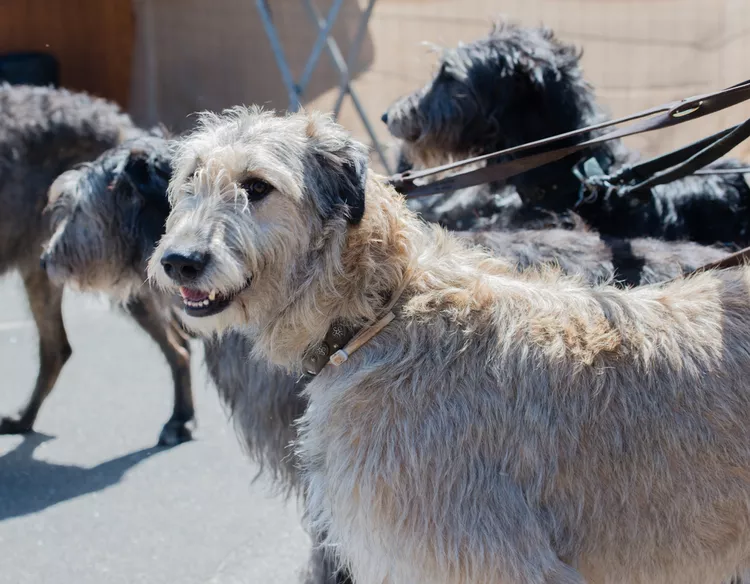
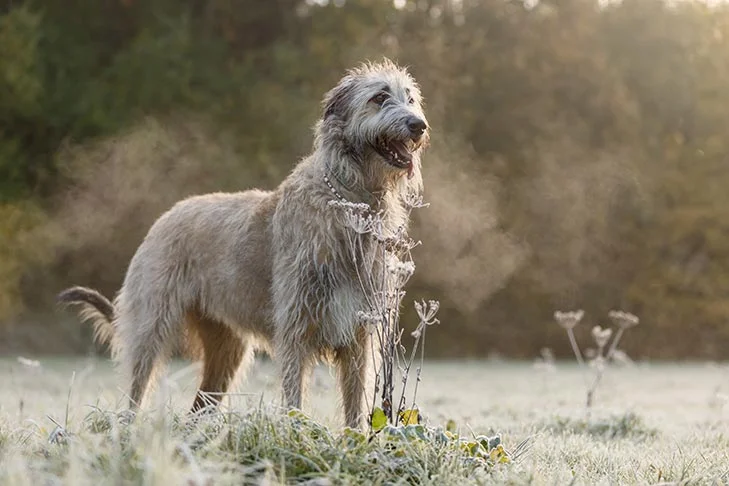
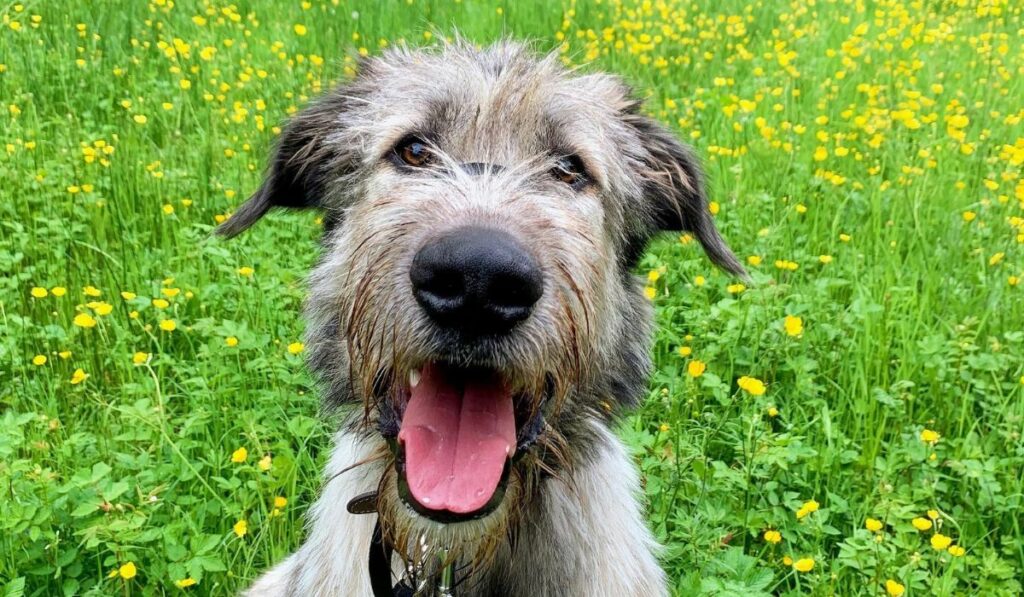
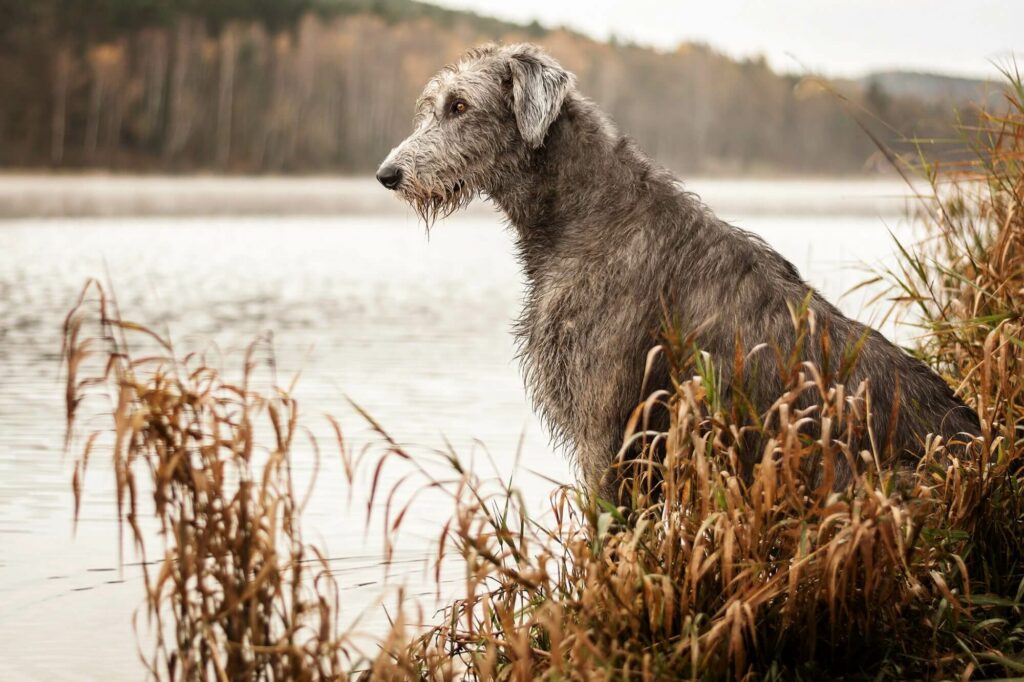
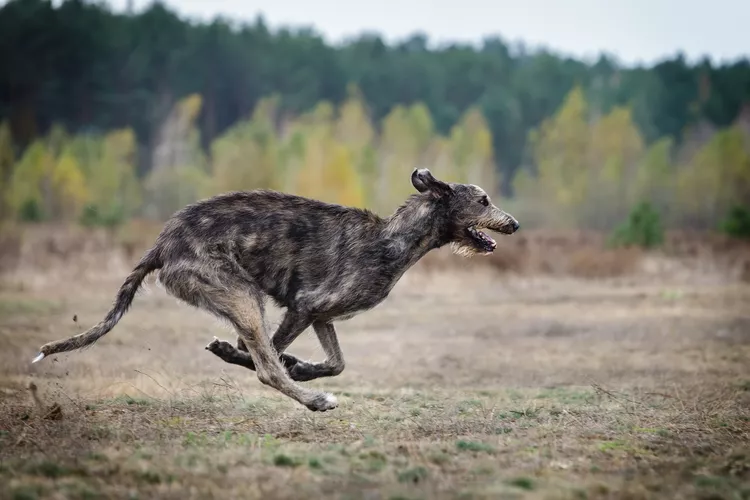
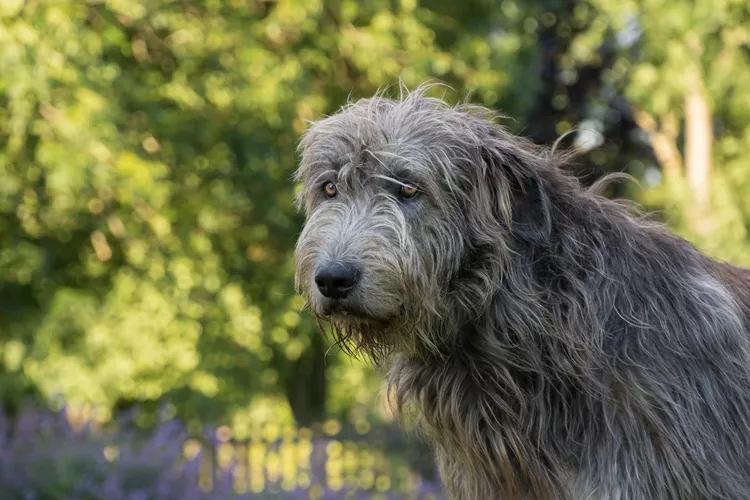
Overview
With a rich heritage, the Irish Wolfhound stands out for its towering size and surprisingly gentle personality. This breed is similar to the Great Dane, among the tallest dogs, but has a unique history and physical features.
Known for its speed and stamina, the Irish Wolfhound was bred for hunting large animals like wolves and elk. It has a deep chest, long limbs, and a strong body that helped it in its traditional role and makes it a great pet today.
The breed standard for an Irish Wolfhound demands a mix of power and elegance, allowing it to remain nimble despite its large size. This balance was crucial for a dog that needed to traverse large distances quickly and with strength. Despite their past as hunters, Irish Wolfhounds are known for their calm and noble temperament, making them as good at being friendly companions as they are impressive in size.
Tall, gentle, and agile, these dogs make both fascinating subjects for those interested in canine history and outstanding family members. The Irish Wolfhound’s combination of physical attributes and friendly nature has secured its place not just in the annals of history but in the hearts of dog lovers worldwide.
Gentle Giant Traits
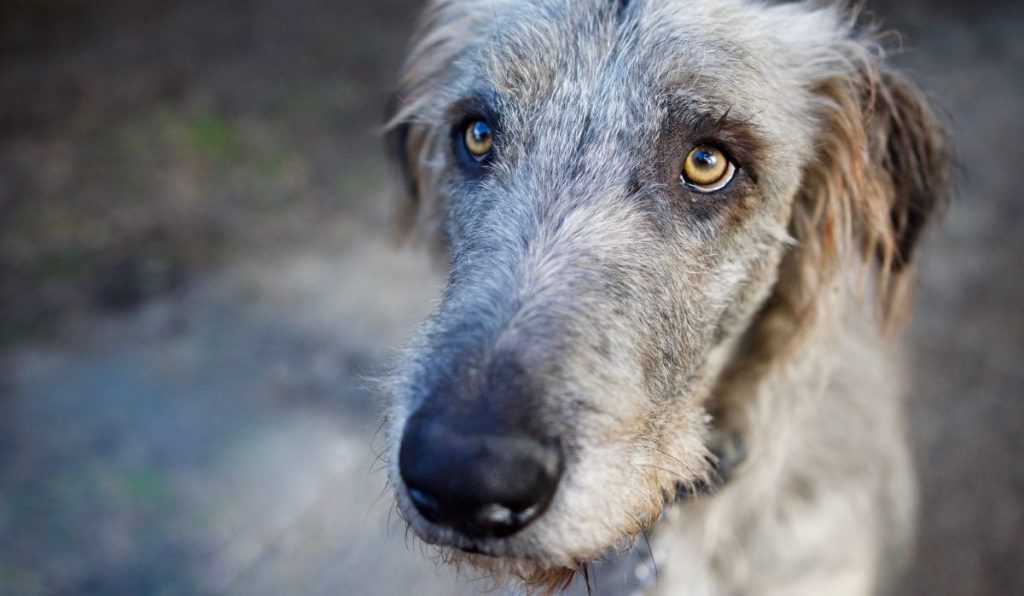
Irish Wolfhounds are the perfect example of gentle giants, blending impressive size with a kind and easygoing personality that makes them beloved by many. These towering dogs remain calm and composed, which is particularly reassuring when around kids.
To fully appreciate the character of Irish Wolfhounds, it’s helpful to look at their everyday behavior and background as hunting dogs. The following table summarizes their key personality traits:
| Trait | Description |
|---|---|
| Noble Temperament | Irish Wolfhounds are known for their regal and gentle nature, often showing a peaceful attitude. |
| Relaxed Energy | Their large size doesn’t stop them from being laid-back, especially at home. |
| Family-oriented | They create strong bonds with their families, showing great loyalty and empathy. |
| Instinct to Chase | They have a natural inclination to chase, stemming from their history as hunting dogs, which is something to watch during outdoor play. |
| Gentle with Others | They are usually very gentle with other animals and children, preferring harmony over conflict. |
Irish Wolfhounds combine their noble look with a loving nature, making them treasured pets for many families.
History of the Irish Wolfhound Family Dog
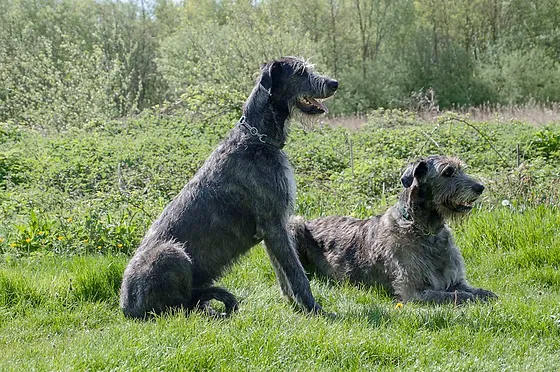
Tracing the origins of the Irish Wolfhound reveals a breed with a deep past and practical beginnings. An analysis of the breed’s history shows:
- Breed Ancestral Roots: Genetic studies point to the inclusion of large dogs bred to fulfill the needs of the time.
- Historical Purpose: These dogs were used for hunting big game and were also prized as noble gifts, which shows their importance and usefulness in society.
- Evolution Over Centuries: The breed underwent periods of decline and resurgence, influencing today’s Irish Wolfhound traits.
The Irish Wolfhound’s lineage is a testimony to its enduring presence throughout history. Their ancestors were large dogs bred for specific roles in their society. These mighty canines were not only hunters of large game but also esteemed as luxurious presents among the nobility, highlighting their dual role in utility and social status. Over time, the breed experienced both lows and highs, which led to concerted efforts to save and define the characteristics we see in the Irish Wolfhound today.
Tallest Dog Breed Ancestral Roots
The Irish Wolfhound has a proud legacy deeply intertwined with Ireland’s history. These dogs were initially bred for hunting and held in high regard by the Irish elite. With the last wolf in Ireland killed in 1786, the Wolfhound’s original purpose faded into history.
The breed we know today primarily exists thanks to Captain George Augustus Graham. In the 1800s, he worked tirelessly to rejuvenate the breed by mixing breeds like the Tibetan Wolf-Dog, Scottish Deerhounds, and Great Danes. His dedication ensured the survival of the Irish Wolfhound’s majestic presence and physical prowess.
Historical Purpose
Tracing back to the 6th century, the Irish Wolfhound is known for its role in hunting and as a status symbol. These large dogs were initially bred to hunt wolves and were prized for their size and hunting skills. The Irish nobility often used the breed as prestigious gifts, showcasing their wealth and influence.
When wolves became extinct in Ireland by the late 18th century, the Irish Wolfhound’s role as a hunter diminished. However, their storied past was kept alive, and efforts to revitalize the breed have made it an enduring symbol of Irish culture.
Evolution Over Centuries
As the need for Irish Wolfhounds in hunting diminished with the loss of their traditional prey, their story through time shows a deep heritage and cultural importance. These dogs appear in old Irish texts as critical members of early Irish communities, prized for their hunting skills, and valued as prestigious presents for the elite.
Later on, the breed became rare due to high demand overseas, prompting a rejuvenation led by Captain George Augustus Graham. He interbred them with Scottish Deerhounds and Great Danes to restore their numbers. The Irish Wolfhound is a symbol of pride in Ireland, known for its deep connection with people and protective nature, despite a friendly approach to newcomers.
The Irish Wolfhound’s evolution reflects the breed’s survival and significance in Irish heritage. Captain Graham’s efforts in the late 19th century were crucial in returning these noble dogs from the brink of disappearance.
Irish Wolfhounds are celebrated as gentle giants, their towering stature and loyal temperament making them beloved companions. They serve as links to Ireland’s past, embodying the country’s history and traditions.
Wolf Hounds Impressive Stature
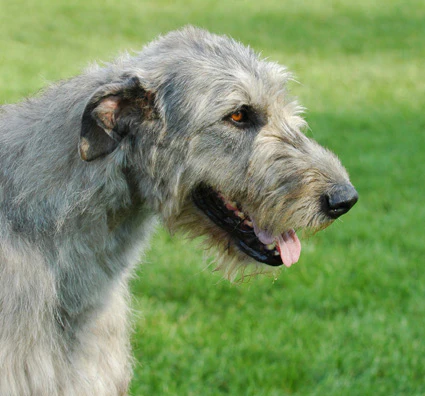
The Irish Wolfhound is renowned for its towering size, making it one of the most giant dog breeds. This characteristic is not just for show; it plays a significant role in their lifestyle needs and the kind of space they thrive in. Owners must consider their living arrangements carefully to accommodate such a large dog.
This breed combines elegance with strength, reflecting their historical use in hunting large animals. Their impressive size can, however, lead to specific health issues. Proactive veterinary care is vital to keep these gentle giants healthy. Owners should stay informed about the breed’s health conditions and work closely with a vet to manage them.
Giant Breed Profile
Irish Wolfhounds tower over other dogs as the tallest breed, with adult males standing at least 32 inches and females at 30 inches at the shoulder. These gentle giants showcase a mix of power and grace, reminiscent of the build of a greyhound. Their long legs, slender frame, deep chest, and low-hanging tail add to their impressive silhouette. The breed’s coat is wiry and medium in length and comes in various colors.
Owning an Irish Wolfhound means being ready to handle their significant needs. These include enough space for them to move around, regular exercise to maintain their health, and special considerations for traveling due to their size. Their coats require regular grooming, and they prefer more relaxed environments to stay comfortable.
Height and Weight
Irish Wolfhounds are known for their impressive size. Females usually stand over 30 inches tall, while males can reach at least 32 inches. They also have a significant weight, starting at 105 pounds for females and 120 pounds for males. These measurements make them the tallest dog breed and reflect their past roles in hunting and guarding.
Irish Wolfhounds can reach 84 inches when standing on their hind legs, highlighting their remarkable size and strength. Despite their large size, they have a build similar to a greyhound, which allows for speed and agility.
Giving them plenty of space and regular exercise is essential to keep these gentle giants healthy.
Physical Presence
Irish Wolfhounds are a sight to behold, towering over many other breeds with their tall frames and muscle-bound bodies. They are living testaments to a past where their size was critical for hunting and battle. These dogs stand proud, with males reaching at least 32 inches at the shoulder and females standing about 30 inches. Their weight reflects their strength, with males generally weighing 120 pounds or more and females around 105 pounds.
Their long legs give them a noble appearance, and their powerful chests suggest they have the endurance needed for the vigorous activities they were bred for. The Irish Wolfhound’s appearance isn’t just for looks; it results from careful breeding to enhance their physical capabilities for demanding tasks.
Stature-Related Health Concerns
The Irish Wolfhound’s impressive size and muscular build come with health issues that owners must watch out for. These large dogs are often affected by joint and bone problems due to their rapid growth and heavyweight. A diet that supports joint health and careful exercise can help prevent these issues.
Heart conditions like dilated cardiomyopathy are also common in this breed, so regular vet check-ups are necessary. Their large size may also increase their risk of bone cancer. Early detection through regular vet visits can be vital in managing this severe condition and helping your Irish Wolfhound live a longer, healthier life.
Comparing Breed Sizes
The Irish Wolfhound stands out for its impressive height, towering over many other large dog breeds. Typically, they measure between 30 and 35 inches at the shoulder, with some dogs even taller. In contrast, breeds like the Great Dane or Mastiff generally stand around 28 to 34 inches tall.
The immense size of the Irish Wolfhound is the result of careful breeding for both strength and size, aimed at creating a dog capable of hunting big animals, a role where the breed has a storied past of success.
Temperament Traits of the Irish Wolfhound Breed
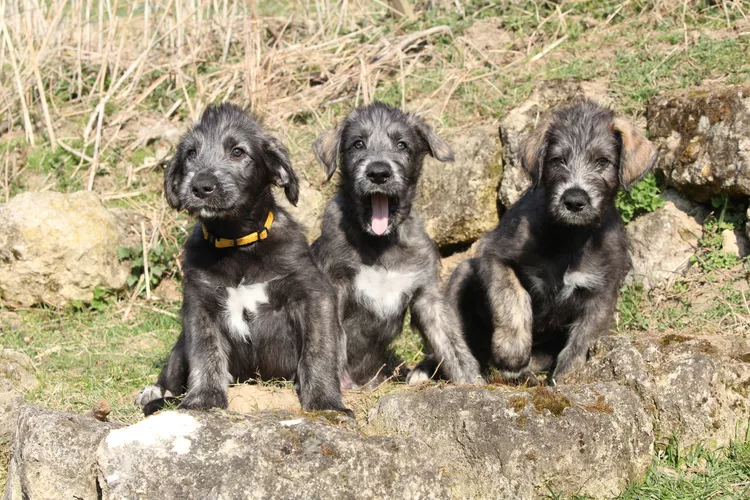
The Irish Wolfhound is known for its friendly and approachable personality, which makes it a beloved breed. They are known for their:
- Gentle Nature: Irish Wolfhounds are known for being calm and kind-hearted despite their large size.
- Family-Oriented: They bond closely with their human families and fit in well at home.
- Pet-Friendly: Their friendly nature also extends to other pets, as they typically get along with them without any issues.
Irish Wolfhounds have a gentle giant personality; their large frames house a tender, serene spirit. They are particularly well-suited for families, forming deep bonds and quickly becoming a part of the family unit. Their sociability also means they live harmoniously with other pets, showcasing their laid-back and non-confrontational demeanor.
These traits make the Irish Wolfhound a cherished companion in many homes worldwide.
Gentle Giant Personality
Irish Wolfhounds are known for their kind nature and impressive size, earning them the nickname ‘gentle giants.’ Their calm demeanor starkly contrasts their large build, making them gentle companions in a home environment. They move with a thoughtful calmness and are typically friendly towards other animals, showcasing their peaceful personality even though they were initially bred for hunting.
These dogs are known for being particularly sweet with children, and breed enthusiasts often highlight their non-confrontational attitude.
When considering bringing an Irish Wolfhound into your home, assessing their needs is essential due to their size. These dogs do best in more relaxed environments and have specific grooming requirements to keep them comfortable and healthy. Understanding these aspects of their care is critical to providing a loving and suitable home for these majestic dogs.
Friendly With Families
Irish Wolfhounds are known for their friendly nature and make excellent family pets. They are incredibly gentle and patient with kids. This breed’s calm and noble temperament fits well into family life, making them great companions.
Irish Wolfhounds are suitable for most homes, even spacious apartments, as long as they exercise enough. They have a moderate energy level and thrive with regular exercise and training.
These dogs are also known for being easy to train, which helps them fit into family life and form close bonds with everyone at home, including other pets.
Sociable With Other Pets
Irish Wolfhounds are known for their friendly nature towards other pets, mainly due to their gentle and laid-back temperament. They have a history as hunters, but these dogs are usually not aggressive to other household animals. When introduced early on, they get along well with others, which helps them live peacefully in homes with multiple pets.
These large hounds are typically calm and not prone to destructive behavior, making them good housemates for various pets. Engaging them in dog sports is a great way to use their energy and promote friendly behavior, making them well-liked companions for many types of animals.
Calm Disposition Traits
The Irish Wolfhound’s laid-back and affectionate nature makes them excellent companions for families and single owners. These large dogs are known for their calmness and sensitivity, contributing to their reputation as gentle domestic giants.
They enjoy relaxing, and despite their size, they are known for their gentle approach to life. They get along well with children, other dogs, and pets, demonstrating their friendly disposition. Owners often form a strong bond with these loyal dogs.
They move leisurely around the house, reinforcing their status as peaceful and loving pets.
Training for Good Manners
Owners of Irish Wolfhounds should start obedience training early to teach their dogs respect and proper behavior. Consistency is critical, and using rewards to reinforce good actions works well.
Getting your dog used to different people, pets, and places is also critical early on. This helps them become pleasant and friendly.
Setting and sticking to clear rules at home is another way to ensure your dog behaves well.
Plus, don’t forget that regular physical activity and brain games are essential to keep your dog’s energy in check and promote their good manners.
Genetic Disease Susceptibility
When looking at the health of Irish Wolfhounds, these large dogs are known for specific health problems linked to their genes. They often face heart and bone conditions that need close monitoring.
Many Irish Wolfhounds carry genes for diseases like dilated cardiomyopathy and osteosarcoma. Breeders should use genetic tests to help avoid these issues.
To protect the health of Irish Wolfhounds, breeders must choose healthy dogs for breeding and act quickly if a problem is found.
Common Health Issues
Irish Wolfhounds are known for their large size and friendly nature. However, they also have some health challenges. These dogs often face heart issues like dilated cardiomyopathy and are prone to bone cancer, particularly osteosarcoma. They can also suffer from bloat, a dangerous condition that affects their stomach. Another concern is a liver disorder called hereditary intrahepatic portosystemic shunt.
Working with trusted breeders and keeping up with vet visits is crucial in keeping these dogs healthy. Catching problems early with regular health screenings can help manage these conditions. This proactive approach can lead these magnificent dogs to a longer, happier life.
Many Irish Wolfhound Inherited Conditions Prevalence
Genetic predispositions are a significant concern for Irish Wolfhounds. Inherited conditions like dilated cardiomyopathy and osteosarcoma significantly influence their mortality rate. Those involved with the breed need to pay close attention to these health issues, as they can dramatically reduce the lifespan of Irish Wolfhounds.
Irish Wolfhounds have a body shape that makes them prone to gastric torsion or bloat. This is a dangerous condition that requires immediate veterinary care. Intrahepatic portosystemic shunt is another inherited disease that disrupts liver function by changing the normal blood flow.
The practice of neutering has been associated with a higher incidence of bone cancer in Irish Wolfhounds. Therefore, it’s necessary to consider the timing of this procedure carefully. Responsible breeders must conduct thorough health screenings to lessen these genetic threats. This helps maintain the breed’s health and ensures the future of the Irish Wolfhound’s heritage.
Mitigating Genetic Risks
A clear plan is needed to tackle the health issues of owning an Irish Wolfhound. Understanding the breed’s common diseases, like heart issues and bone cancer, is vital. The Irish Wolfhound Club of America offers resources to help owners grasp these health concerns. Working with breeders who prioritize health screening and keep extensive records is a smart move. Adopting an Irish Wolfhound from a rescue can also be beneficial, as their health history is often available, aiding in health management.
Consistent vet visits, a balanced diet, and regular exercise are critical factors in minimizing the effects of hereditary conditions. Staying updated on new animal healthcare and genetics developments can prepare owners to manage their Irish Wolfhound’s health better.
Owners should focus on preventive care for their Irish Wolfhound’s well-being. Partnering with ethical breeders or adopting from rescues with transparent health histories are good practices. Regular vet check-ups, proper nutrition, and exercise contribute to a healthier life for these dogs. It’s also helpful to stay informed about the latest in veterinary medicine and genetic testing to manage potential health issues proactively.
Giant Dog Grooming Requirements
Maintaining an Irish Wolfhound’s coat is essential for their well-being. A regular grooming routine is crucial, including brushing their coat weekly. This helps to keep their thick fur free from tangles and maintains its natural rough texture.
It’s important to bathe an Irish Wolfhound at intervals that clean their coat without stripping it of protective oils. Also, trimming their nails and cleaning their ears regularly is vital to avoid discomfort or health problems. These steps help in keeping your Irish Wolfhound healthy and comfortable.
Coat Brushing Frequency
Grooming your Irish Wolfhound should be a regular part of your routine, with brushing their medium-length, wiry coat at least once a week. This keeps it free from tangles and build-up of dirt and fur. A consistent brushing schedule helps control shedding and removes dead hair, which keeps your dog looking good and supports healthy skin by spreading the coat’s natural oils.
Regular grooming sessions are perfect for checking your dog’s skin and coat for unwanted visitors like ticks or fleas. This weekly brushing routine is vital to caring for your Irish Wolfhound and is significant in their health and happiness.
Bathing Schedule Tips
When caring for an Irish Wolfhound, keeping their coat clean and healthy with a good bathing routine is essential. Aim to bathe your Irish Wolfhound every one to two months to keep their skin and fur in top shape without stripping away essential oils.
During bath time, it’s an excellent chance to check their ears and nails, which should be done weekly and monthly to catch any potential health concerns early. Including combing and stripping in their regular grooming can make a big difference in their overall well-being.
Remember that less is often more when bathing to maintain your Irish Wolfhound’s impressive coat. Bathing too frequently can dry out their skin. Please stick to the recommended bathing schedule and pair it with consistent grooming practices, like brushing and stripping, to manage shedding and maintain a sleek, healthy coat.
Regular grooming keeps your Wolfhound looking great and strengthens your relationship with your pet.
Nail Trimming Practices
Keeping an Irish Wolfhound’s nails short is crucial for their well-being. Regular cuts with the right tools, like guillotine or scissor clippers, help prevent discomfort and mobility issues. Keep styptic powder ready in case of any accidental nicks. It’s vital not to cut the quick, as it’s painful and may cause the dog to resist future nail care.
Training an Irish Wolfhound to be comfortable with nail trims from a young age is beneficial. If owners are unsure how to trim nails properly, seeking advice from a groomer or vet is wise, especially since this breed is active and needs regular exercise.
Proper nail care is part of keeping an Irish Wolfhound healthy. The essential skills are using the correct clippers and quickly avoiding them. Having styptic powder on hand is a safety measure for any accidents. Starting nail care routines early helps the dog get used to the process. If you’re not confident, ask for help from a professional. This is especially important for an active breed like the Irish Wolfhound, which relies on healthy paws for daily activities.
Ear Cleaning Guide
Nail care, like ear care, is crucial for an Irish Wolfhound’s ability to move comfortably and is critical to preventing infections and maintaining health. A regular ear cleaning schedule is necessary for Irish Wolfhounds to stop wax build-up and avoid possible ear problems.
Owners should use a vet-recommended ear-cleaning liquid and gently wipe the inside of the ears with cotton balls, careful not to touch the ear canal. It’s important to stay alert for any unusual smells, discharge, or signs of discomfort in your dog’s ears. If you notice anything odd, get in touch with your vet right away.
Maintaining a consistent ear-cleaning process is an integral part of grooming that keeps your dog’s hearing in good shape.
Seasonal Shedding Insights
Irish Wolfhounds undergo noticeable coat changes with the seasons, leading to much shedding. Pet owners must adjust how often they groom these large dogs when there’s more fur to manage. The shedding gets heavier when the days and temperatures change, signaling to the dog that it’s time to shed its dense undercoat. This helps the Wolfhound stay comfortable in different weather.
To handle all the extra hair, brushing these dogs daily during heavy shedding times is best. This keeps their coat in good shape and reduces the amount of hair around the house.
For young Irish Wolfhound puppies, a regular grooming routine is critical. It helps control shedding and encourages a healthy coat as they grow. Sticking to a grooming schedule is more than just about cleanliness; it also strengthens the connection between the dog and its owner.
Dietary Regimen
The health of an Irish Wolfhound hinges significantly on their diet, which requires thoughtful planning and knowledge. Proper nutrition is crucial for these large dogs, ensuring they get all the necessary vitamins and minerals to stay healthy.
A clever feeding routine is essential to reduce the chance of bloat, a dangerous condition in large breeds that does not leave the dog alone. Offering meals at set times can help prevent this issue. Choosing quality foods that support the breed’s growth needs is critical to avoid bone and joint problems. This means looking for ingredients that promote robust bone health and proper development.
Nutritional Requirements
Irish Wolfhounds need a diet tailored to their large size and growth patterns. To keep them healthy, it’s important to include plenty of lean proteins, essential vitamins, minerals, and fatty acids. These dogs should eat several small meals daily to prevent bloat, a common issue in large breeds. Since they increase, monitoring their calorie intake is crucial to avoid bone and joint problems.
Regular exercise is vital for Irish Wolfhounds; a spacious yard allows them to move around. This helps manage their weight and contributes to their overall health.
Regular check-ups with a vet will ensure their diet is on track. It’s all about providing the right balance to support their health and vitality.
Feeding Schedule
Creating a regular feeding routine is crucial for the health of Irish Wolfhounds. These large dogs should eat twice daily to fulfill their high energy needs due to their massive size, often exceeding 32 inches at the shoulder.
These dogs need a specialized, high-quality diet to prevent health issues such as bloat, which they are prone to due to their large chests. Their food intake should be carefully measured and adjusted based on how much exercise they get.
Having set meal times helps their digestion and makes training and keeping them on a schedule more manageable. It’s essential to work with a vet or dog nutrition expert to create a diet plan that fits the unique needs of an Irish Wolfhound, ensuring they stay healthy and live a whole life.
Suitable Food Choices
Ensuring your Irish Wolfhound receives high-quality proteins is crucial for keeping their hefty frame and active lifestyle in top shape. Their diet should carefully mix nutrients, focusing on bone and joint support through glucosamine and omega-3 fatty acids.
It’s essential to feed them in a way that supports gradual growth, particularly in the puppy stage, to prevent joint problems later on. Always consult a vet to create a diet plan for this specific breed.
To help prevent gastric torsion, a severe health issue, feeding your Wolfhound several smaller meals throughout the day is recommended. This approach aligns with the best dietary practices for this breed’s health.
